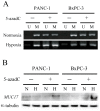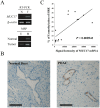Expression of MUC17 is regulated by HIF1α-mediated hypoxic responses and requires a methylation-free hypoxia responsible element in pancreatic cancer
- PMID: 22970168
- PMCID: PMC3438193
- DOI: 10.1371/journal.pone.0044108
Expression of MUC17 is regulated by HIF1α-mediated hypoxic responses and requires a methylation-free hypoxia responsible element in pancreatic cancer
Abstract
MUC17 is a type 1 membrane-bound glycoprotein that is mainly expressed in the digestive tract. Recent studies have demonstrated that the aberrant overexpression of MUC17 is correlated with the malignant potential of pancreatic ductal adenocarcinomas (PDACs); however, the exact regulatory mechanism of MUC17 expression has yet to be identified. Here, we provide the first report of the MUC17 regulatory mechanism under hypoxia, an essential feature of the tumor microenvironment and a driving force of cancer progression. Our data revealed that MUC17 was significantly induced by hypoxic stimulation through a hypoxia-inducible factor 1α (HIF1α)-dependent pathway in some pancreatic cancer cells (e.g., AsPC1), whereas other pancreatic cancer cells (e.g., BxPC3) exhibited little response to hypoxia. Interestingly, these low-responsive cells have highly methylated CpG motifs within the hypoxia responsive element (HRE, 5'-RCGTG-3'), a binding site for HIF1α. Thus, we investigated the demethylation effects of CpG at HRE on the hypoxic induction of MUC17. Treatment of low-responsive cells with 5-aza-2'-deoxycytidine followed by additional hypoxic incubation resulted in the restoration of hypoxic MUC17 induction. Furthermore, DNA methylation of HRE in pancreatic tissues from patients with PDACs showed higher hypomethylation status as compared to those from non-cancerous tissues, and hypomethylation was also correlated with MUC17 mRNA expression. Taken together, these findings suggested that the HIF1α-mediated hypoxic signal pathway contributes to MUC17 expression, and DNA methylation of HRE could be a determinant of the hypoxic inducibility of MUC17 in pancreatic cancer cells.
Conflict of interest statement
Figures






Similar articles
-
DNA methylation and histone H3-K9 modifications contribute to MUC17 expression.Glycobiology. 2011 Feb;21(2):247-56. doi: 10.1093/glycob/cwq155. Epub 2010 Oct 6. Glycobiology. 2011. PMID: 20926598 Free PMC article.
-
The HIF1alpha-inducible pro-cell death gene BNIP3 is a novel target of SIM2s repression through cross-talk on the hypoxia response element.Oncogene. 2009 Oct 15;28(41):3671-80. doi: 10.1038/onc.2009.228. Epub 2009 Aug 10. Oncogene. 2009. PMID: 19668230
-
Hypoxia-inducible factor 1-mediated human GATA1 induction promotes erythroid differentiation under hypoxic conditions.J Cell Mol Med. 2012 Aug;16(8):1889-99. doi: 10.1111/j.1582-4934.2011.01484.x. J Cell Mol Med. 2012. PMID: 22050843 Free PMC article.
-
Hypoxic Effects on Matrix Metalloproteinases' Expression in the Tumor Microenvironment and Therapeutic Perspectives.Int J Mol Sci. 2023 Nov 28;24(23):16887. doi: 10.3390/ijms242316887. Int J Mol Sci. 2023. PMID: 38069210 Free PMC article. Review.
-
Hypoxia: a barricade to conquer the pancreatic cancer.Cell Mol Life Sci. 2020 Aug;77(16):3077-3083. doi: 10.1007/s00018-019-03444-3. Epub 2020 Jan 6. Cell Mol Life Sci. 2020. PMID: 31907561 Free PMC article. Review.
Cited by
-
Exploring the role and diversity of mucins in health and disease with special insight into non-communicable diseases.Glycoconj J. 2015 Nov;32(8):575-613. doi: 10.1007/s10719-015-9606-6. Epub 2015 Aug 4. Glycoconj J. 2015. PMID: 26239922 Review.
-
Untouchable genes in the human genome: Identifying ideal targets for cancer treatment.Cancer Genet. 2019 Feb;231-232:67-79. doi: 10.1016/j.cancergen.2019.01.005. Epub 2019 Jan 24. Cancer Genet. 2019. PMID: 30803560 Free PMC article.
-
MUC17 Is a Potential New Prognostic Biomarker and Promotes Pancreatic Cancer Progression in Obstructive Jaundice.Oncology. 2025;103(8):725-741. doi: 10.1159/000541874. Epub 2024 Oct 11. Oncology. 2025. PMID: 39396510 Free PMC article.
-
Hypoxia-induced oxidative stress promotes MUC4 degradation via autophagy to enhance pancreatic cancer cells survival.Oncogene. 2016 Nov 10;35(45):5882-5892. doi: 10.1038/onc.2016.119. Epub 2016 Apr 25. Oncogene. 2016. PMID: 27109098 Free PMC article.
-
Pancreatic cancer early detection: expanding higher-risk group with clinical and metabolomics parameters.World J Gastroenterol. 2015 Feb 14;21(6):1707-17. doi: 10.3748/wjg.v21.i6.1707. World J Gastroenterol. 2015. PMID: 25684935 Free PMC article. Review.
References
-
- Jemal A, Siegel R, Ward E, Hao Y, Xu J, et al. (2009) Cancer statistics, 2009. CA: a cancer journal for clinicians 59: 225–249. - PubMed
-
- Semenza GL (2003) Targeting HIF-1 for cancer therapy. Nature reviews Cancer 3: 721–732. - PubMed
-
- Bhaskar KR, Garik P, Turner BS, Bradley JD, Bansil R, et al. (1992) Viscous fingering of HCl through gastric mucin. Nature 360: 458–461. - PubMed
-
- Ho SB, Dvorak LA, Moor RE, Jacobson AC, Frey MR, et al. (2006) Cysteine-rich domains of muc3 intestinal mucin promote cell migration, inhibit apoptosis, and accelerate wound healing. Gastroenterology 131: 1501–1517. - PubMed
Publication types
MeSH terms
Substances
Grants and funding
LinkOut - more resources
Full Text Sources
Medical
Research Materials

